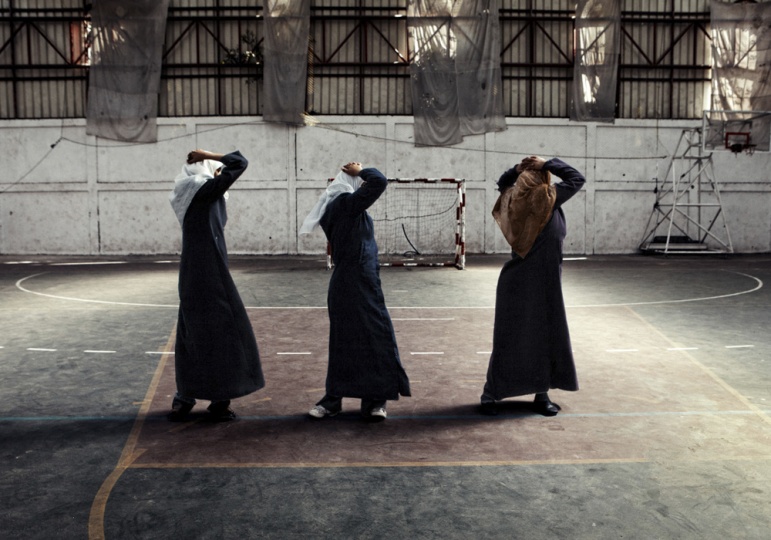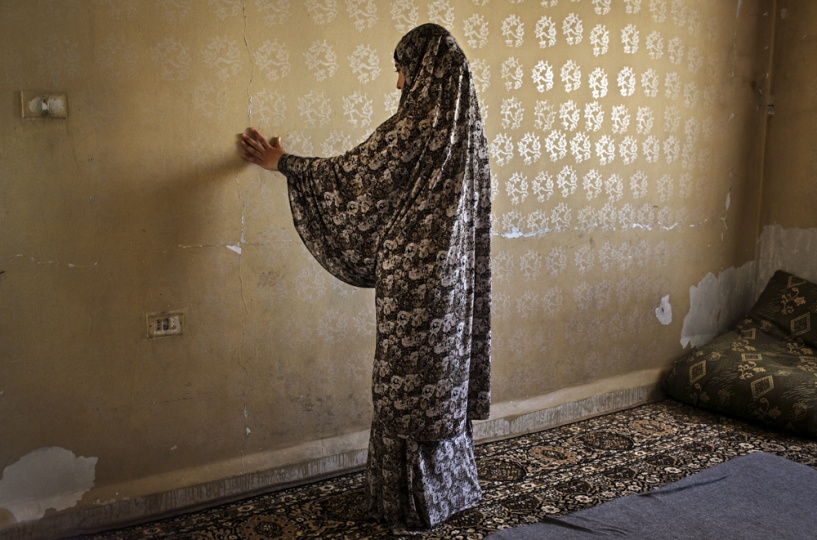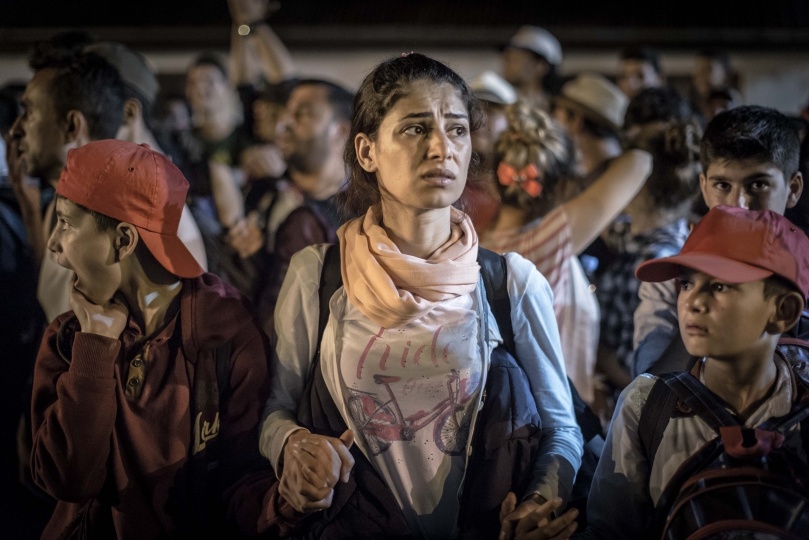Tips: Telling Visual Stories
Everyone has a right to dignity. Use creative approaches. Photograph objects. Maintain confidentiality. Work with reporters you trust. Think about how you’d want your own story told. Don’t be afraid of taking a beautiful shot. Remember why you're there.

"Occupied Pleasures": Young women, fully dressed in jilbab, exercise in a gym in Gaza. The women say they cover at the gym because they have no privacy in the public sphere due to limited economic options.
Editors note: This tip sheet, compiled by Karen Brown, was inspired by presentations given by Sima Diab and Tanya Habjouqa at the Dart Center’s 2019 reporting institute in Amman, Jordan: “Covering Children and the Syrian Refugee Crisis.” Watch the full video here.
In many ways, photography can be an invasive form of journalism – remember that no matter how much you try, you can’t melt into the background.
One challenge is knowing when to photograph. Your humanity should always take precedence. You might need to wait until after an interview with a reporter. Some photographers wait to take a camera out until the time feels right, in order to build trust. Others always have their camera out, to make it clear why they’re there. Sometimes you have to put your camera down, either to give subjects a break or to help out when that’s necessary. You’re there to photograph, so at some point you’ll need to pick it up again, unless you find the time just isn’t right or that it’s inappropriate to continue. This is a gut feeling, it’s reading the room, it’s understanding your subjects and in the end, it’s basic decency.
Abdel Rahman Rahmoun, 17, lays on a mattress on the floor in a rented hom in Reyhanli, Turkey, December 29, 2015. Abdel Rahman's legs were amputated after a Russian bomb struck a few meters from where he was standing outside his home.
Syria via Whatsapp | Tanya Habjouqa / NOOR
In a world saturated with images, use creative approaches in photography. One reason people stop really seeing pictures is because they’re all shot in the same way. Avoid the tropes, and capture the refugee face in dignity. Tell a story through facial expressions – like a mom holding the hands of her sons. Sometimes photos can ask more questions than give answers – and promote important conversations.
Passport, lifejacket, lemons: What Syrian refugees pack for the crossing to Europe Left: Houthaifa, 21, poses for a portrait in a friend's home in Cairo, Egypt. Houthaifa plans to leave Egypt through the Mediterranean Sea. Houthaifa says he endured torture in Syria's jails and harrassment in Egypt and that he is determined. Right: Houthaifa's belongings. He intends to keep everything light, taking with him only a bottle of water, his military papers and ID and a jacket
If you’re limited in what you can shoot, photograph the objects of people’s lives. Show belongings of someone who’s leaving everything behind. That approach became a whole project that many NGOs ended up using as a frame for the refugee experience. Or use objects to tell a story – like, children’s shoes – to show their concrete experience.
Always think about why you’re there – what is your purpose in watching this misery unfold? Know that your work is important, and you’re not just adding to the noise. You’re there to come up with a new way to tell the story, a better way. If you’re there for one story, always keep your eyes open to another.
Tomorrow There Will Be Apricots: Five years in the lives of Syrian women in Jordan Fadia, 19, traces cracks in the walls of her rented apartment as she describes the death of her father. After returning home from his job as a construction laborer, shortly before the dawn prayer, he collapsed right away onto his bed, dusting the sheets with the debris that fell from his work clothes. Not long after, the shabiha (pro-regime militia) burst into their home and shot him, execution style, in the head.
Think up creative ways to maintain confidentiality, to not show faces. Maybe have someone cover their face with their hands. Or have a child cover her parent’s face. Making this process collaborative with your subject, so they maintain their agency, can be an important tool.
Work with reporters/writers you trust. It’s important to respect each other’s work, and each other’s space. Work together to build trust among subjects, sometimes over many months. When this isn’t possible, talk to the reporter beforehand so no one is stepping on each other’s toes. Talk about how to approach sensitive subjects together, and be on board with each other’s code of ethics.
Spot news can be very chaotic and quick. Shocking images are part of reality. Sometimes you don’t have time to get consent in hectic situations. But remember you are human, and professionals break down, too.
A Syrian woman holding the hands of two boys on the platform of a train station, waiting for a train in Tovarnik, Croatia. Many refugees and migrants were hoping to move further West to Europe during a large movement of people over the summer of 2015. September, 2015.
It can be very hard to photograph your own community – and very painful. You always imagine yourself in that situation. It’s common to feel guilt at not having it as bad as your subjects.
To tell a better story, think about how you’d want your own story told. Give people agency in how they want to tell their story. Ask where they’d like to be photographed, or how they’d like to be photographed. Being collaborative in the approach can make for more trust with your subject and lead to stronger imagery.
A man reacts inside the campus of the Coptic Cathedral after an explosion killed over 20 people on Dcember 11, 2016 in Cairo, Egypt.
Don’t be afraid of taking time to perfect/layer/compose a more meaningful image. Sometimes you feel guilty about paying attention to the aesthetic of a photo when your subjects are going through such pain – but taking a truly good photograph gives more meaning to the subjects’ time and experience. Maintain a strong sense of purpose and know you’re doing this work for a reason.
Work with the time you’re given. If you’re only given a few minutes to shoot a story (often after a long interview with a writer/journalist), use that waiting period to take in the environment, to look for clues or visuals that will enhance the story. Sometimes, you can also ask to take photos as they’re talking.



































































































